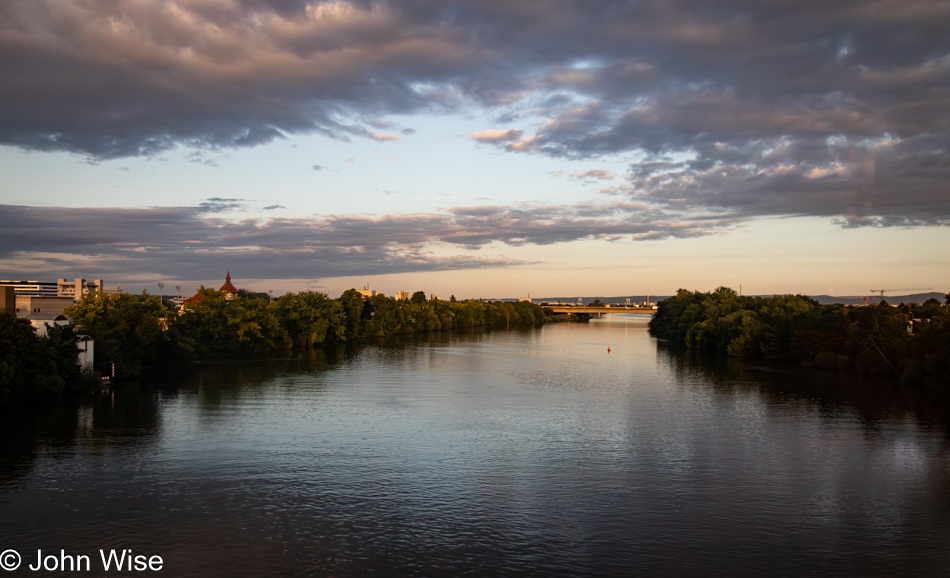
There we were, after little more than three full days in Germany, dragging our bags out of Heddernheim over to the Zeilweg tram stop to make our way to the airport. We’d powered through the jetlag and did everything we intended to during our first 72 hours in Frankfurt, though, on the other hand, there’s never enough time for family. Talking with Rouven at Jutta’s assisted living facility yesterday, we discussed the problem of elderly people and those with dementia who’ve not accepted or become aware of their situation. Well, about to leave for Denmark, I considered our hefty itinerary and had to wonder if this was 30-year-old John making plans for 60-year-old John and his 55-year-old wife. At what point will my ambition outgrow the circumstances of our stamina? Maybe the best answer is to remain in motion and always be aware of what we’re typically able to do on a day-to-day and week-to-week basis and use that as a measure of what we might be able to carry into our vacations.
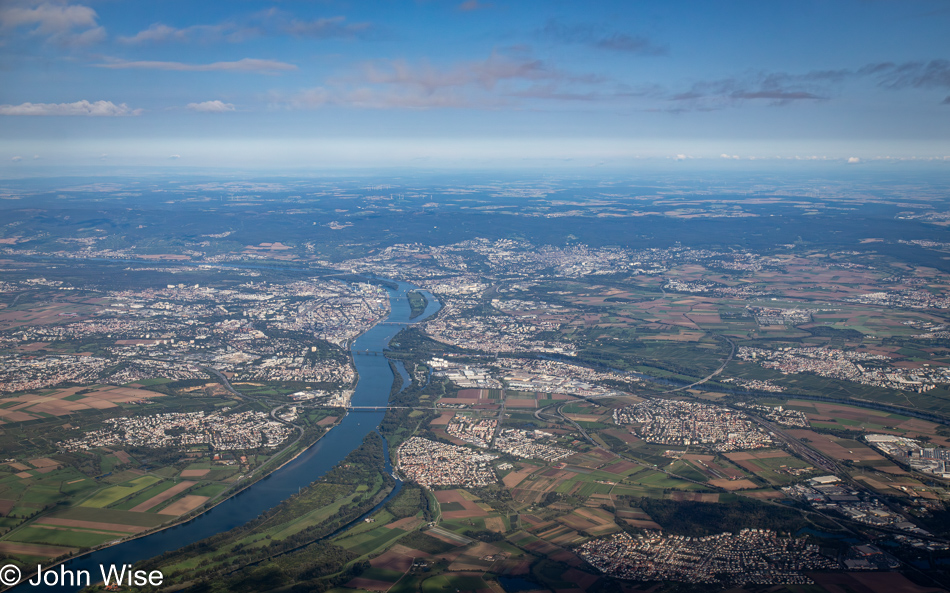
Seated onboard on our flight out of Germany without my book, all I have are my thumbs to twiddle. Of course, I could write, and that’s what I’m doing while not playing Guess Where We Are, which, of course, is where the Main flows into the Rhein River at Mainz, but the idea of doing so for the 80 minutes we’ll be in the air feels impossible since my ability to identify geography from 35,000 feet over earth is fairly limited. Maybe I should close my notebook and focus on what shenanigans I can break out to bother my seatmate, who also happens to be my wife because there is nothing like deploying some pesky little annoyances I’ve gained such mastery over to entertain at least one of us.
The captain of our SAS flight starts addressing us passengers with, “Herdy dur schmer floompty flerpty der a florgen bork glurgan.” Oh my god, Swedish Chef from the Muppet Show is at the helm! Minutes later, food service began so I can only guess that his announcement was saying something about lunch. Hmmm, our lunch is not like the others. I’d forgotten that we bought business class on this flight, which could easily be overlooked because the seats were not separated from the rest of the flight, but we were in the first group to board, so there’s that, and now there’s this lunch. Yum, an open-faced pastrami sandwich with a salad of roasted carrot, quinoa, pickled canola seeds, and lovage, a side of rutabaga pickled in apple cider vinegar, and a cream of Sörmlands Ädel cheese from Jürss Mejeri.
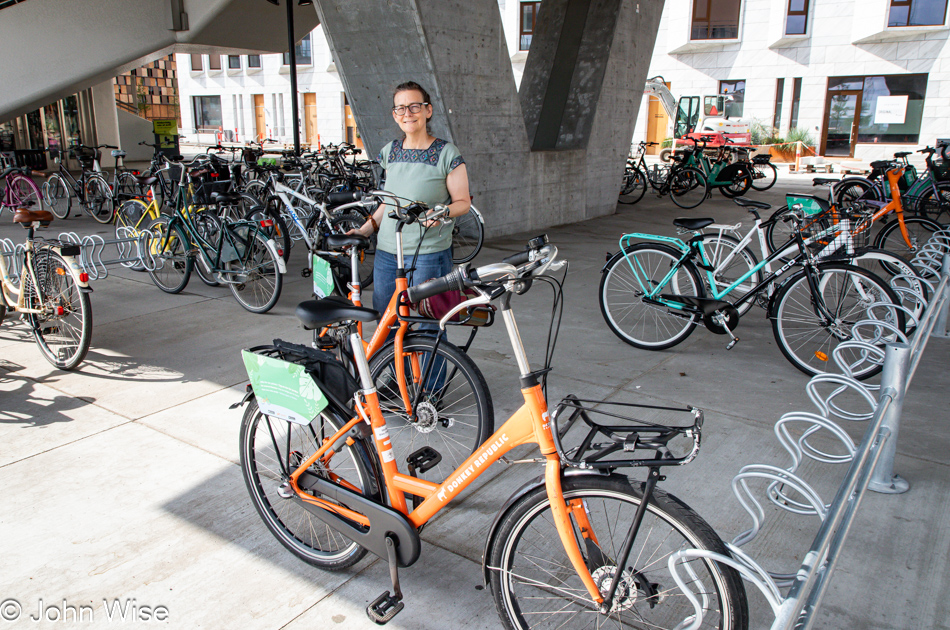
We land just before 11:30 and are quick to negotiate the ticket automat for the metro from the airport to Kongens Nytorv, where we’ll transfer to another train that will take us to our hotel in Nordhavn. With our bags stored until we check in this evening, we are right back at the Orientkaj metro stop looking for Donkey Republik rental bikes. In a couple of minutes, things are figured out, and we are on our way, in a bit of a hurry, actually.
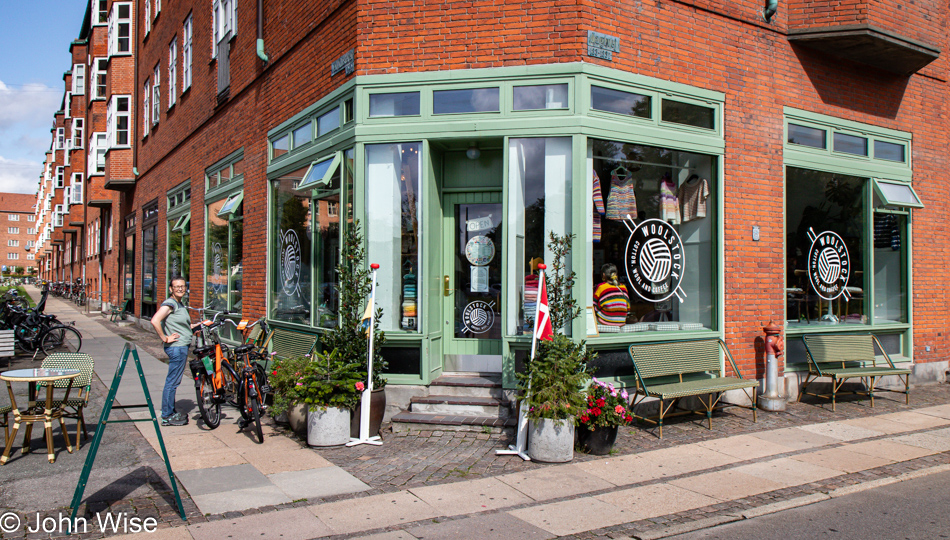
Wow, proper bike lanes segregated from cars with their own lights make for a totally different riding experience that feels incredibly safe. And what could be so important here on our first-ever visit to Copenhagen that we raced there? Our first Danish yarn store experience should be the only plausible answer. I should point out that this won’t be the only yarn store we’ll visit today and that is the real cause of the need for expediency. Prior to leaving the States, I could see that the way between the two shops was best traversed by foot or bike, but with the second shop located closer to the historic center of Copenhagen and closing at 3:00 pm, we’d have to reach Woolstock first and then head into town. Public transport wouldn’t work, so I searched for a bike service and came up with a plan that would have us cycle west from the hotel, south from the first shop, and then, from the next shop, we’d be well positioned for lunch, which could also be considered second lunch seeing we ate on the plane.
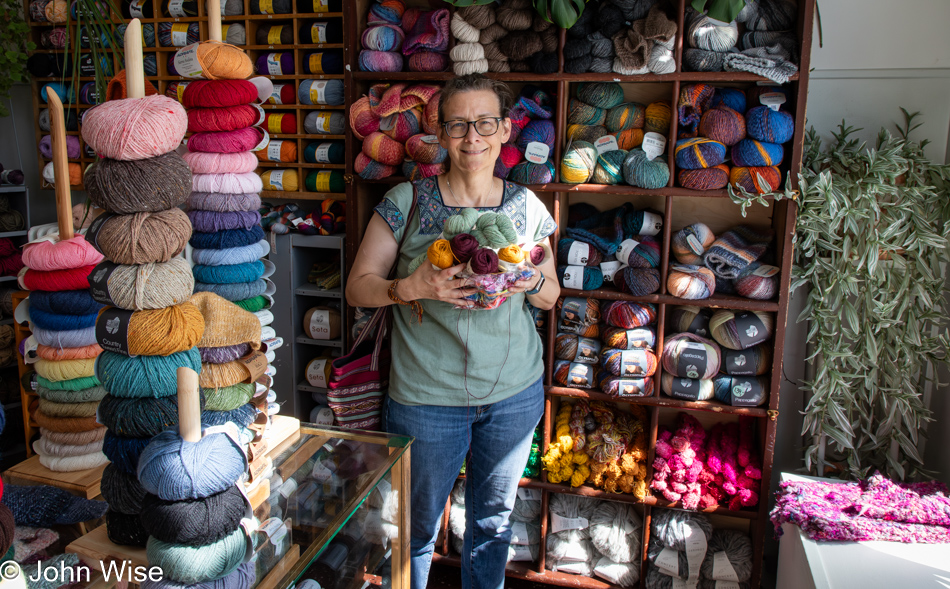
The truth needs to emerge: our flight and landing time in Copenhagen was strategically calculated to thwart Caroline’s ability to linger too long in each yarn store because if there wasn’t some kind of limiting factor going on, she’d spend the entire day petting the skeins and rubbing them on her cheek in a softness check verging on the sensual side of near-naughtiness. This shop has the “Keep them here all day” formula seriously figured out, with their tables and chairs strategically placed in the windows to subconsciously appeal to these cat lovers and the idea of relaxing in the warming sun. Second, they have a cafe with a fully loaded pastry case and a coffee and tea menu. Third, computers are not welcome, but lingering to knit and enjoy the company of your fellow fiber junkies while indulging in sweets and yarn is seriously encouraged, catered to even. Okay, I was joking about the timing to limit Caroline’s moments of indulgence. These vacations are all about mutual basking in privilege. Finally, the green yarn was my choice, but it turns out that its weight might not work so well for socks, so how about a beanie or scarf, Caroline?
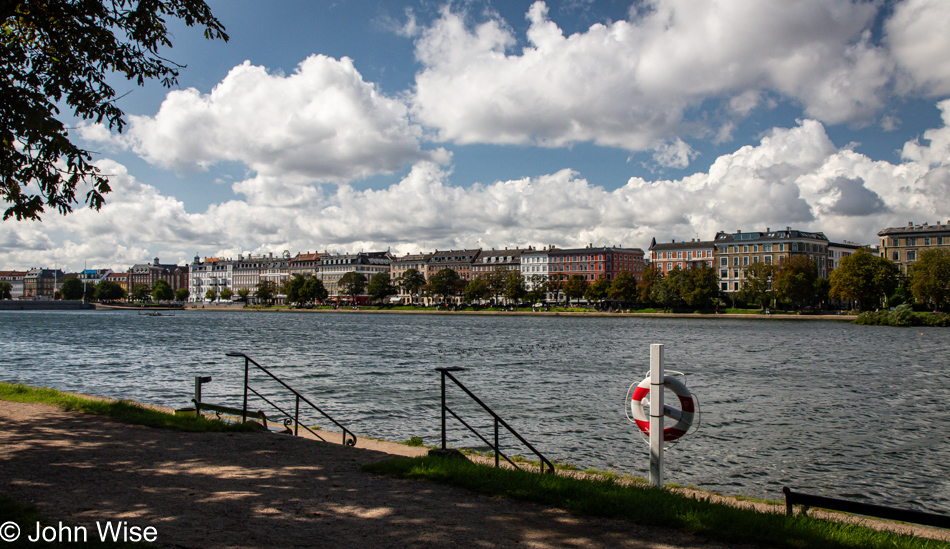
Riding next to one of the lakes on our way to the next stop, it feels as though Richard Wagner was here with us, conducting the Walkürenritt as Caroline leads the way to Valhalla. As she goes forth, she’s reciting the 10th-century poem titled Eiríksmál, taken from the Prose Edda compiled by 13th-century historian Snorri Sturluson, which was originally written in honor of Erik Bloodaxe:
What sort of yarn is that, Odin?
I dreamed I knitted before dawn
to clear up Val-hall for fiber artists.
I aroused the Einheriar,
bade them get up to wind the skeins,
clean the needles,
the valkyries to serve tea
for the arrival of a knittress.
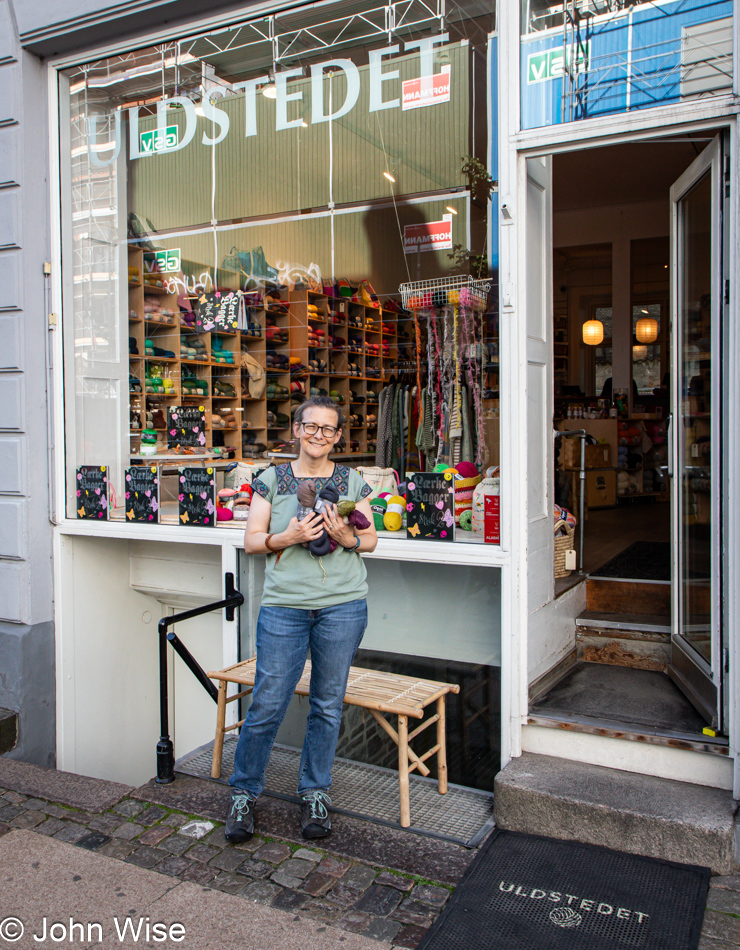
If this were a pirate-inspired story, Caroline would have pillaged her way to collecting the finest fiber booty, but this being a Viking-influenced narrative means that after riding to the lake, she ditched her bike, sailed across the lake to arrive at Old Town Yarn (Uldstedet) in order to raid it and plunder it of all of its best yarns. With only a small Karve (Viking longship) docked at the shore, she’s acting as a responsible seafarer, and, not overloading her craft, only four skeins were seized.
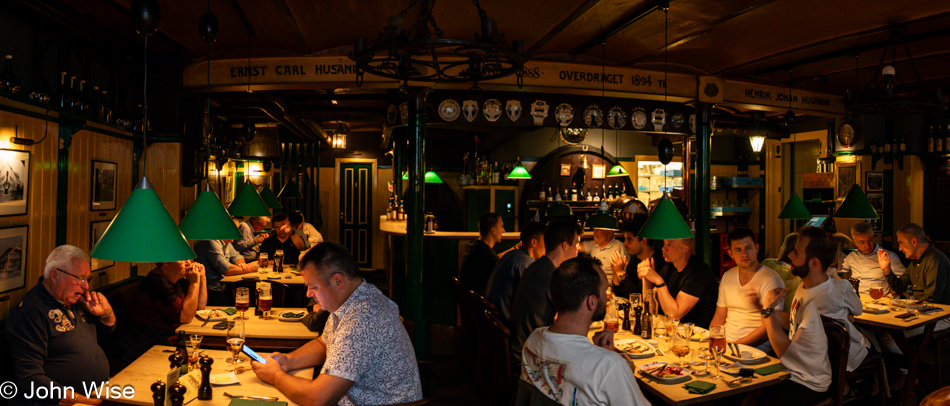
Searching for authentic flavors of Denmark, I came across what is possibly the most famous dish of this country, Smørrebrød, and the restaurant that serves up some of the best in Copenhagen is known as Husmanns Vinstue. They’ve been serving up these open-faced sandwiches called Smørrebrød since 1888, and the basement dining area looks like it hasn’t changed in a century. Oddly, there’s only one other woman here.
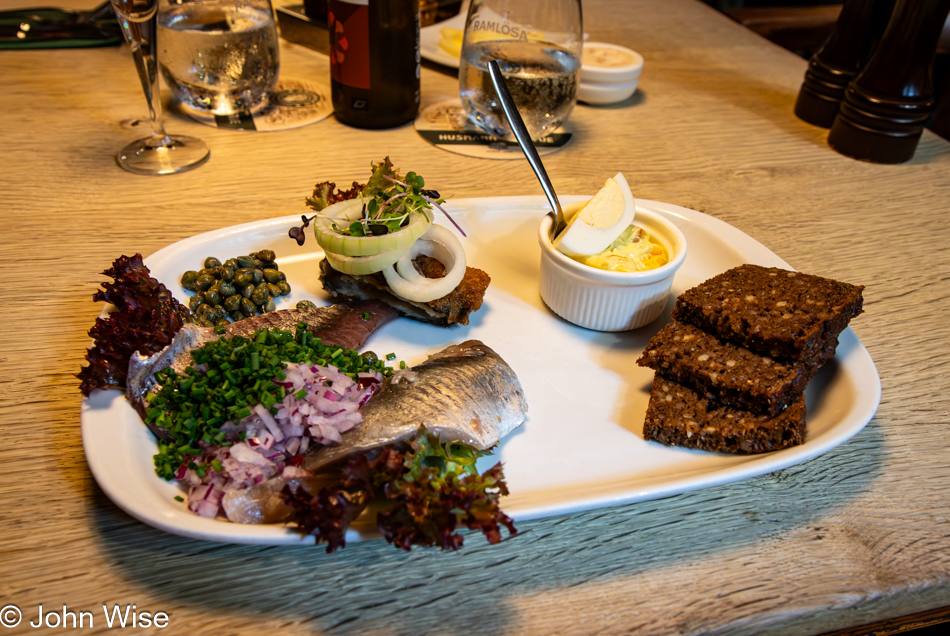
We are in awe sitting in this place with our only wish possibly being that we were here with others to celebrate the authenticity that is washing over us. Before the dishes arrived, Caroline ordered a Nørrebro Bryghus Ravnsborg Red Beer and a shot of Aalborg Taffel Akvavit (Aquavit) to accompany her three types of herring while I stuck with sparkling water (alcohol-free) paired with my first steak tartare of the trip and not the last. With two egg yolks, onion, caper, curry pickle, and freshly shaved horseradish on a slice of rye bread, I was ecstatic with my perfect choice. Seeing other customers enjoying a fried Camembert Smørrebrød with lingonberry jam as a savory treat after their main meal inspired us to share one.
What an amazing environment! We are definitely at home here and of the right age. Alcohol is flowing fast in this relic from yesteryear, which only adds to the charm and volume of the patrons. There’s no way to capture what this place offers the senses. Smørrebrød will forever be defined by this afternoon as this single experience in a local joint without one other foreigner will have cemented the idea that we’ve had a real Danish moment outside the more typical tourist stops. While we’ve hung out for more than an hour by now, we are not ready to leave, but there’s so much more to see, so off we go.

From pickled fish and raw meat indulgences, we fell into the street to catch a demonstration of peaceful vegans protesting meat and fur that was heading to Burger King. With bellies full of sin and having left our rental bikes behind, we walked along for a few minutes, though we abstained from joining the chant lest we appear to be hypocrites.
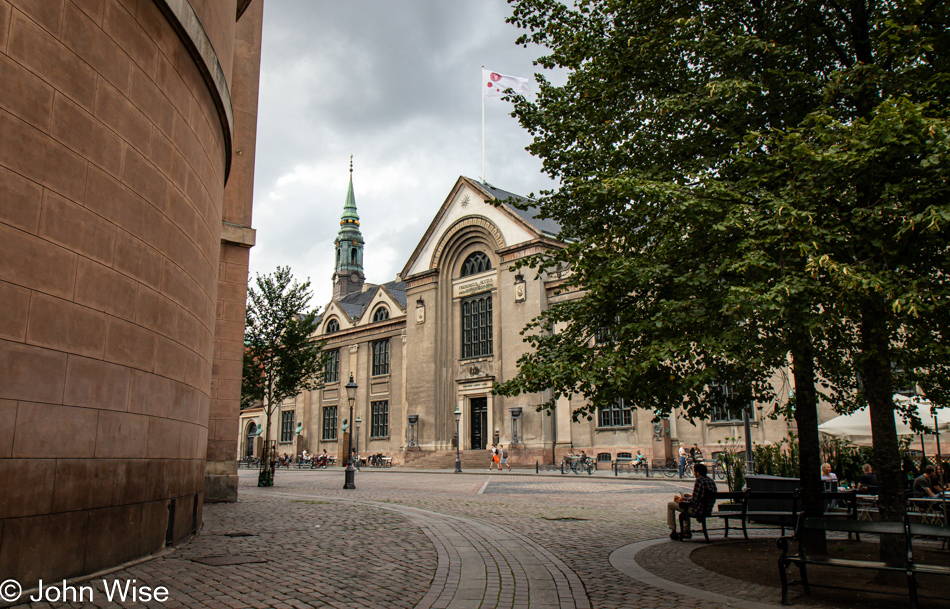
With all the important stuff out of the way, we could now focus on our touristic obligations with jaws agape, gazing upon history and the elegance to be found in capital cities. The building in the background is part of the University of Copenhagen, while we are about to visit the National Cathedral of Copenhagen on the left.
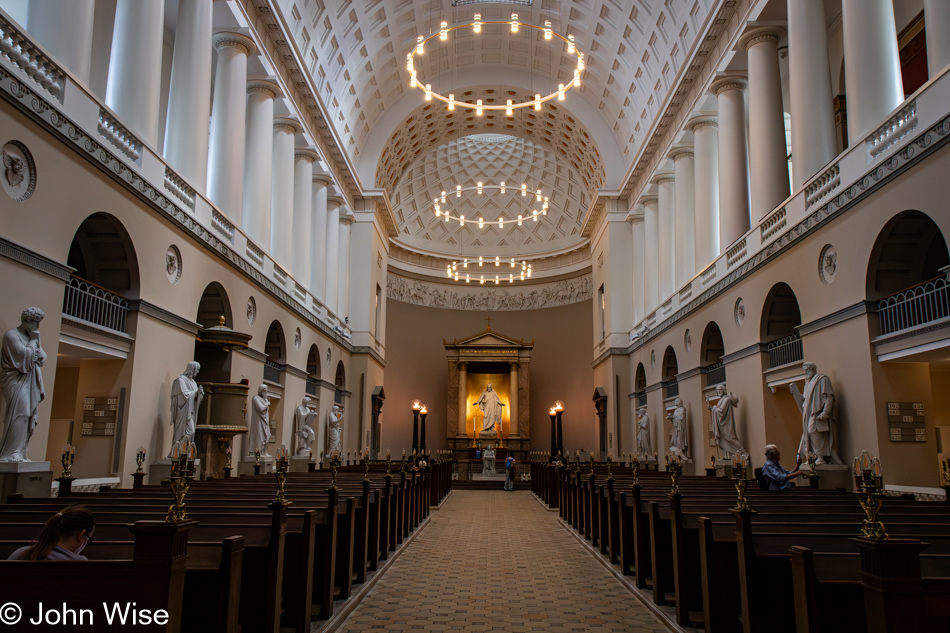
This is the Vor Frue Kirke (Church of our Lady), a.k.a. the National Cathedral. While the site has hosted a few church buildings since about 1187, the longevity of each iteration was marred by fire, war, and the move to Lutheranism.
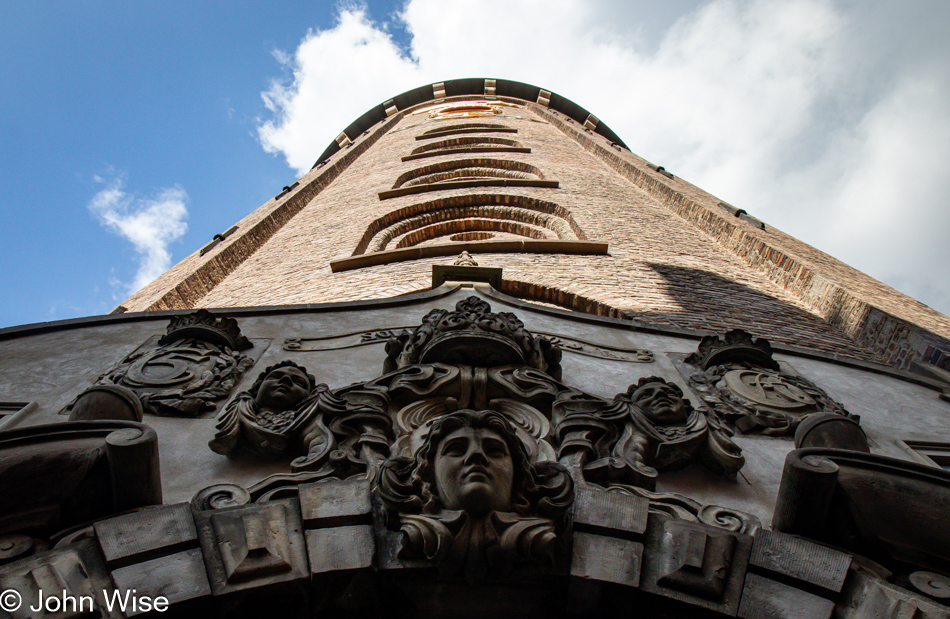
The Round Tower observatory was built in 1642 and is part of the Trinitatis Complex, a project initiated by King Christian IV of Denmark (1577 – 1648), who was also the longest-serving monarch of Danish royal history.
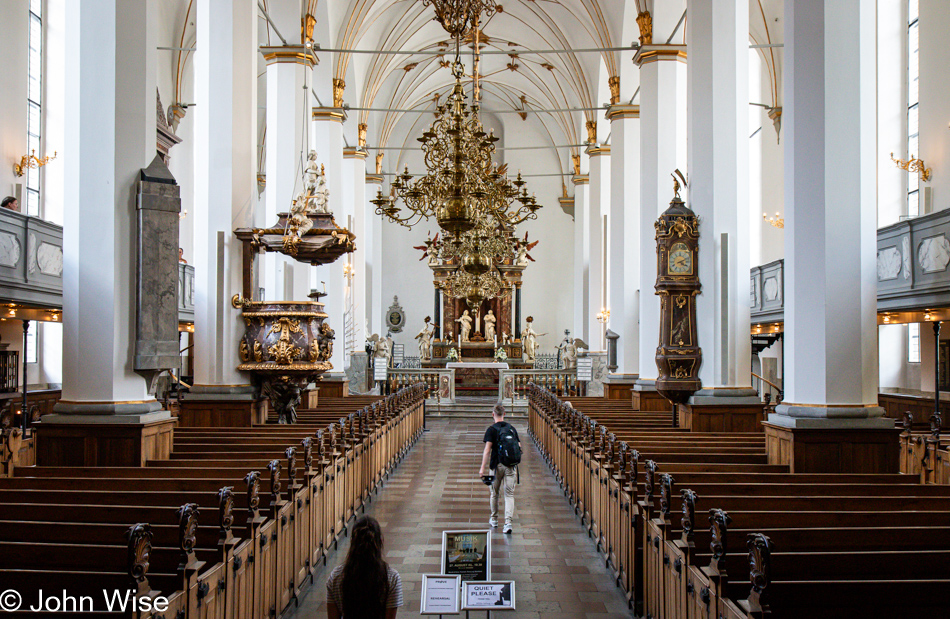
This is the Trinitatis Church, which is connected to the Round Tower. Fortunately, I took this photo through a pane of glass from within the tower because by the time we made it back down, it was after 4:30, and the church was closed.
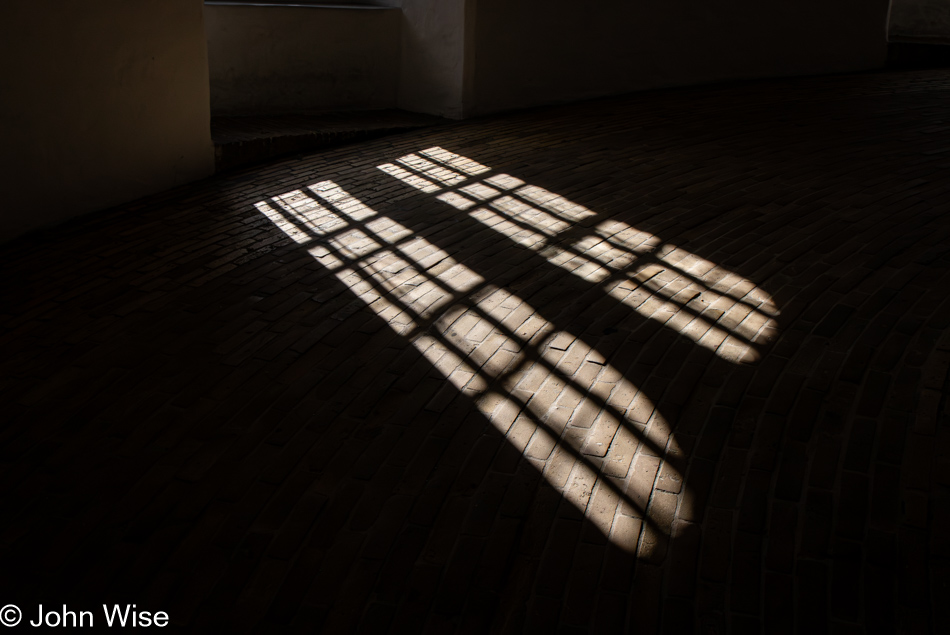
Back in 1716, Tsar Peter the Great of Russia rode his horse up the tower, and while the article mentioning this specifically says “ascended” there’s no mention if he rode it down. Here we were 307 years later no longer having the option to ride a horse up the 7.5 spirals that lead to the top of the tower. Caroline had to drag me instead.
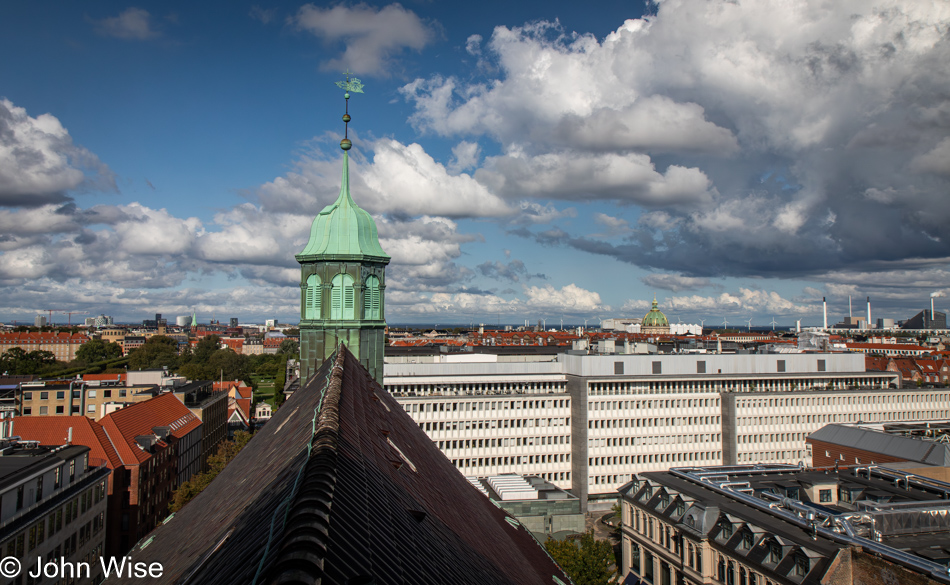
While Tycho Brahe (1546 – 1601) hailed from Copenhagen (his name will come up a few times while we are here), this tower was never visited by the famous astronomer who died before the invention of the first telescope and the construction of the Rundetårn (Danish for Round Tower).
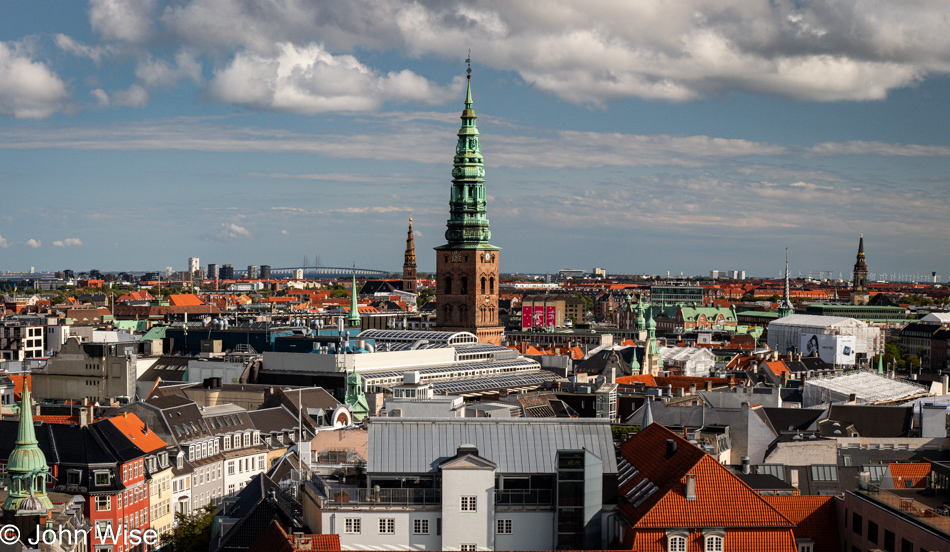
Seen left of center in the distant background is the Øresund Bridge connecting Denmark to Sweden, which at a length of 8km is the longest bridge in Europe, but that’s not the reason Caroline knows of it. She has been watching a Swedish/Danish crime show called The Bridge.
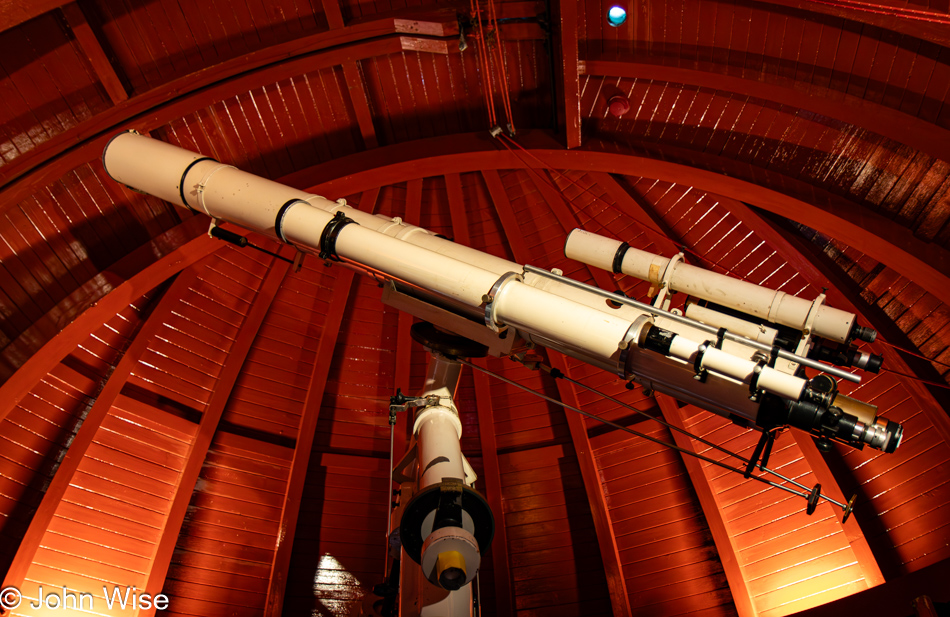
While the Round Tower is the oldest functioning observatory in Europe, light pollution has effectively rendered that title meaningless. Though for its historic relevance, it’s still an amazing piece of architecture to visit.
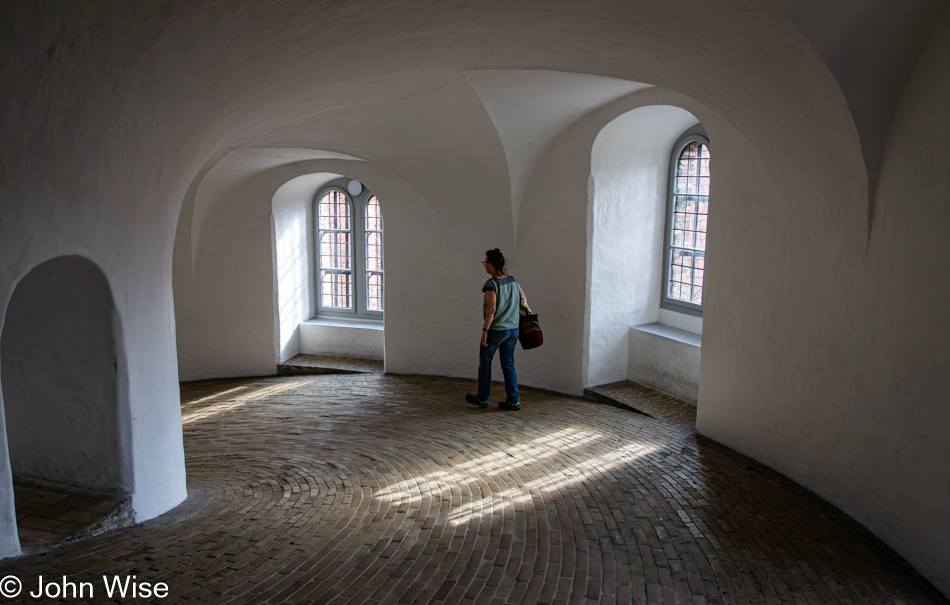
From Wikipedia: The winding corridor has a length of 210 m, climbing 3.74 m per turn. Along the outer wall, the corridor has a length of 257.5 m and a grade of 10%, while along the wall of the inner core, the corridor is only 85.5 m long but has a grade of 33%.
Considering this is the only building of its kind and knowing that most everything visited by tourists would be closed by the time we left the tower, we were in no hurry to depart. Then there was the spectacular weather we’d not expected, so why not linger for a while and enjoy the view?
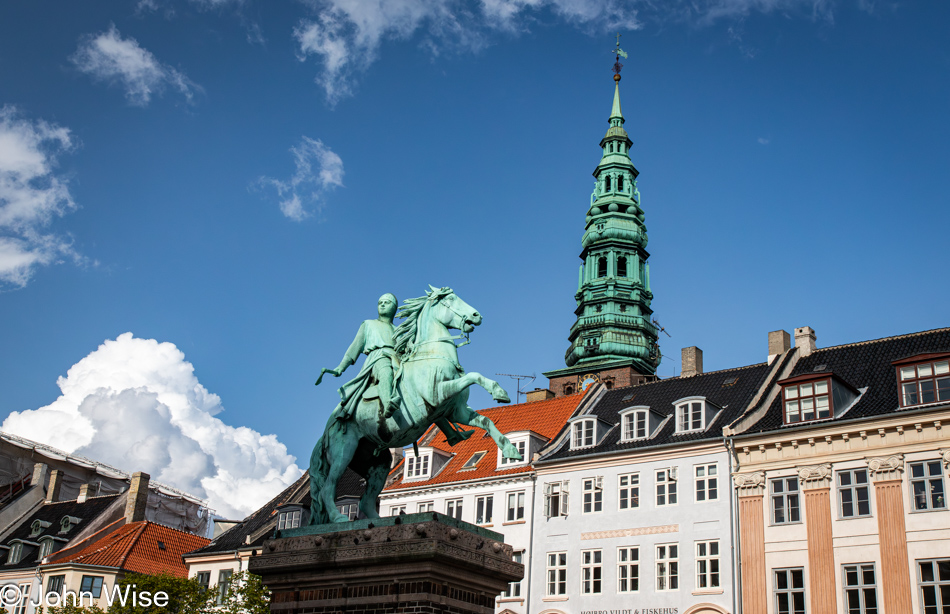
This statue depicts Bishop Absalon, who is said to have founded Copenhagen back in 1167. I’d like to share here that when noting things such as this is a statue of Absalon, as he’s also simply known, I end up reading quite a bit about the history of people, persons, and places that I identify. I often look for interesting facts to offer here, but history tends to be so complex that writing anything more than a date or tidbit of trivia would do a disservice to the story that should be included in greater depth should I say anything more than what’s written, so I simply have to skip it.
This being a blog, I’ve already exceeded the acceptable idea of how long a post should be in consideration of the attention spans of potential readers, but the reality is that this content is written for Caroline and myself. On the way into these histories, I connect dots such as the fact that Snorri Sturluson was alive at the same time as Absalon. While I’m not sure what good this will do me as I write this, it does fill in a part of the history of different geographic regions that allows me to better understand an age that might otherwise be a void.
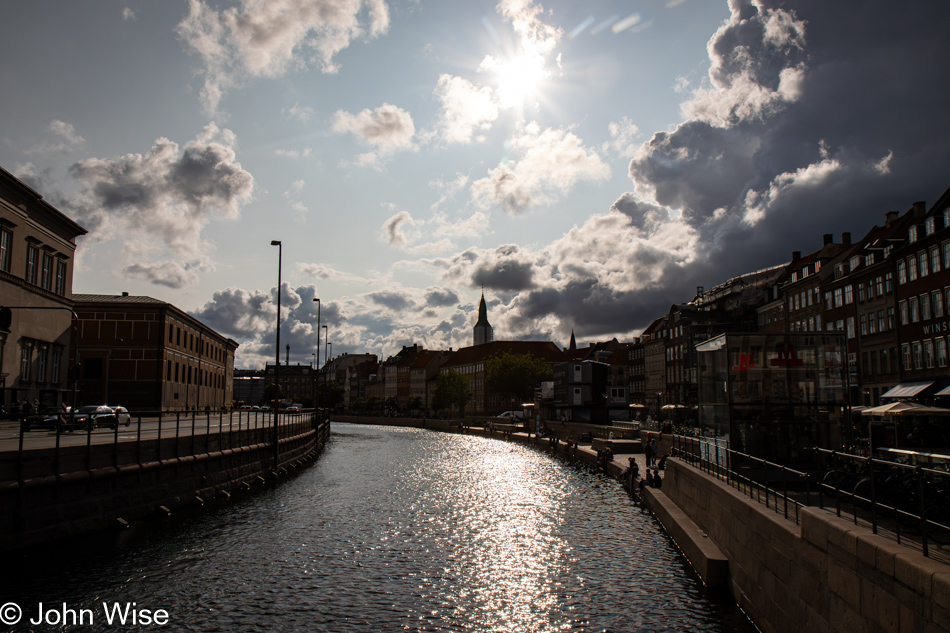
While I love city centers I have some ambivalence about focusing on them, especially when they’ve become major tourist attractions. It’s hard to take the pulse of a place if we don’t have some understanding of everyday life for the people who call that place home. Our first day in Copenhagen started in the Nordhavn neighborhood, and the first leg of our bike ride took us over to Ydre Østerbro before riding into the city core. Enjoying the luxury of not having to rush to open sights, we walked not exactly aimlessly, but still, it was a bit of a meander.
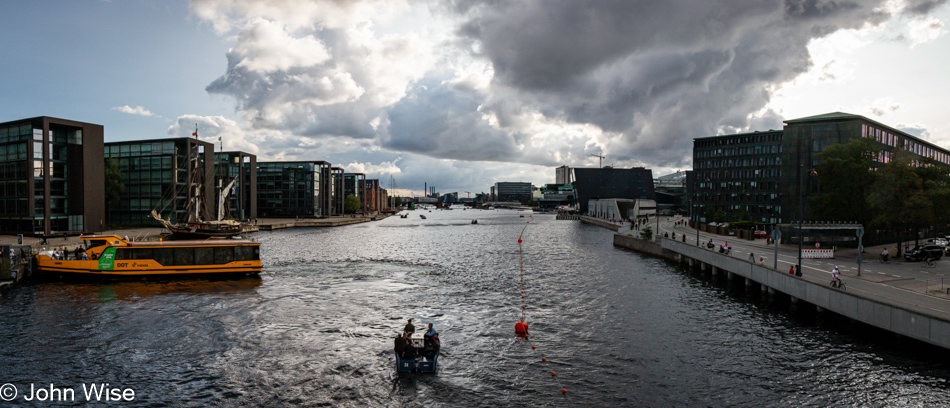
Gathering a sense of the layout of a city has always been one of the great aspects of my introduction to a new locale. One downside of this introduction comes with the need to typically be expedient about our exploration instead of having a week or two to linger in observation. Obviously, I could never truly be satisfied with a couple of weeks either because then my curiosity turns to differences experienced at various times of the year. With the majority of tourists gone when January rolls around, who are the people who’ll be found on the waterways in a kayak at daybreak on a Sunday morning, enjoying the quiet solitude of paddling through their city? As winter gives way to spring and the jackets are put away, what’s the vibe in the cafes knowing that longer days are ahead?
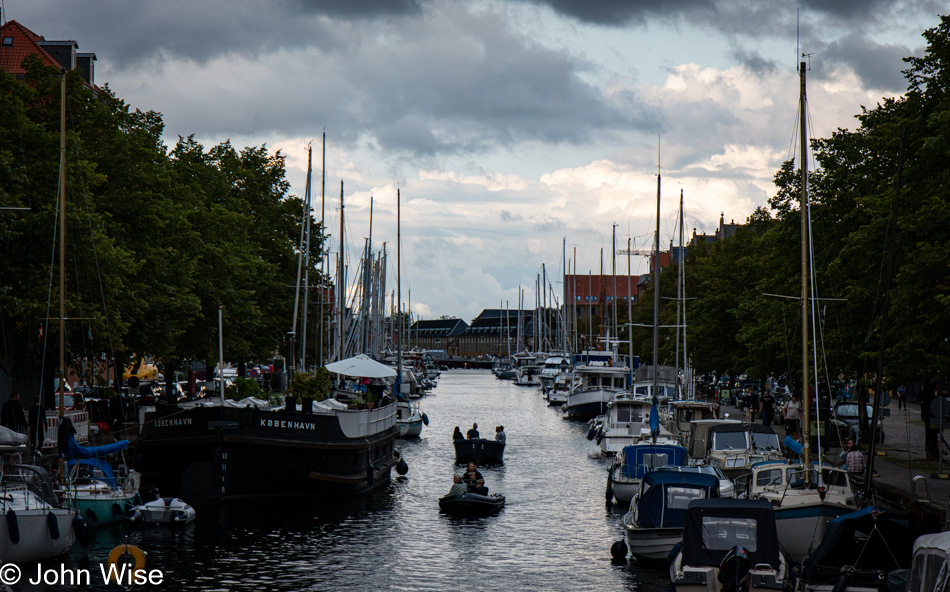
As we stroll along, I’m on the lookout for Lars von Trier, as one never knows whom one might run into. While not encountering any celebrities, we were granted a glimmer of a rainbow out on the horizon, but my photo of it wasn’t as glamorous as I would have hoped for, so no rainbows in this post. Out on the waterways, it appeared that nobody cared about stars or rainbows. The nice weather here at the end of summer invited those who could join the flotilla of partiers to bring out their boats and friends for a drink and a bite to eat while casually motoring through the city. What a nice contrast to our life in the desert.
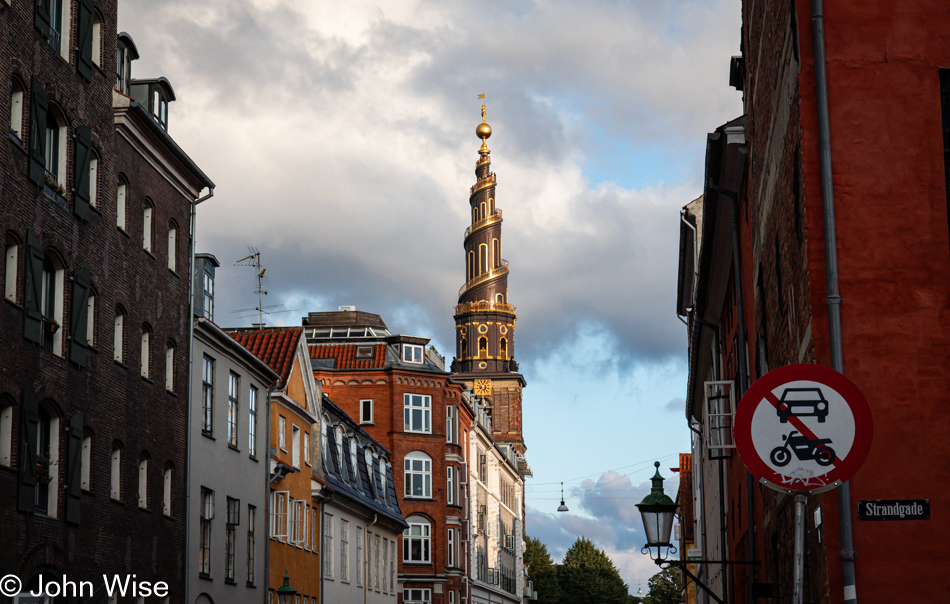
The spiral tower here belongs to the Church of Our Saviour, and while it’s open late, it is sold out for the day, which will prevent us from visiting it this trip. That’s right, we have our sights set on a return. Not that I didn’t already know this when we arrived in Copenhagen earlier today, but then again, it should be evident that we’re always up for return visits to cities of historic importance.
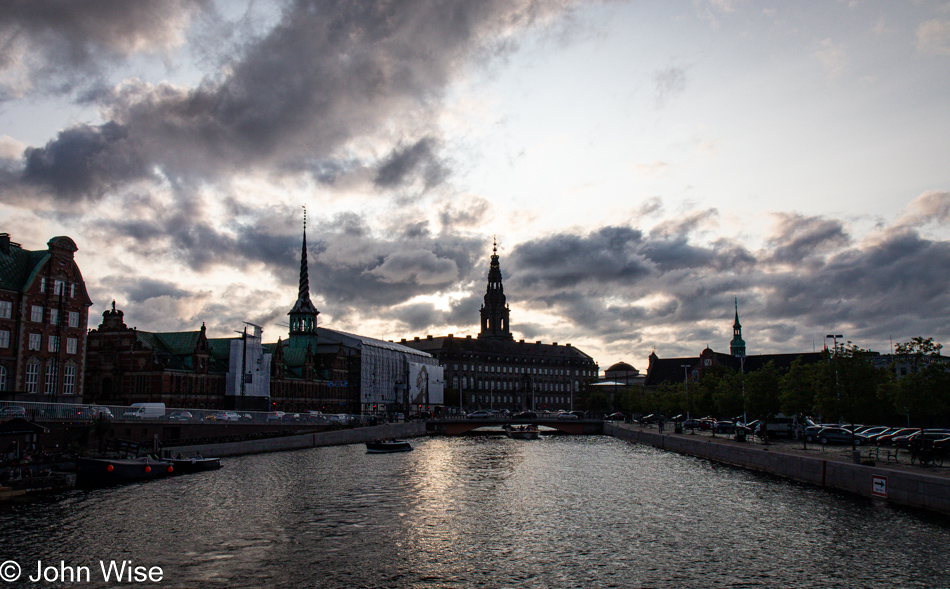
We just kept on walking until we started lagging, but that was rectified by a coffee and a shared pastry, or would that be more accurately described as a Danish? [Note: Danish people call “Danish pastries” wienerbrød, or “Viennese bread” – Caroline] Revitalized, it was time to return to the polite streets of Copenhagen. I have to say “polite” because, unlike in Germany or the U.S., pedestrians have rights of way I’ve not seen elsewhere. When pedestrians approach an intersection with a crosswalk, we are not expected to slow down or stop. We just keep on walking as the drivers are aware that we are about to step in front of them. This is a difficult habit to pick up quickly enough for the drivers who are not going to pass through the intersection until after we’ve crossed the street.
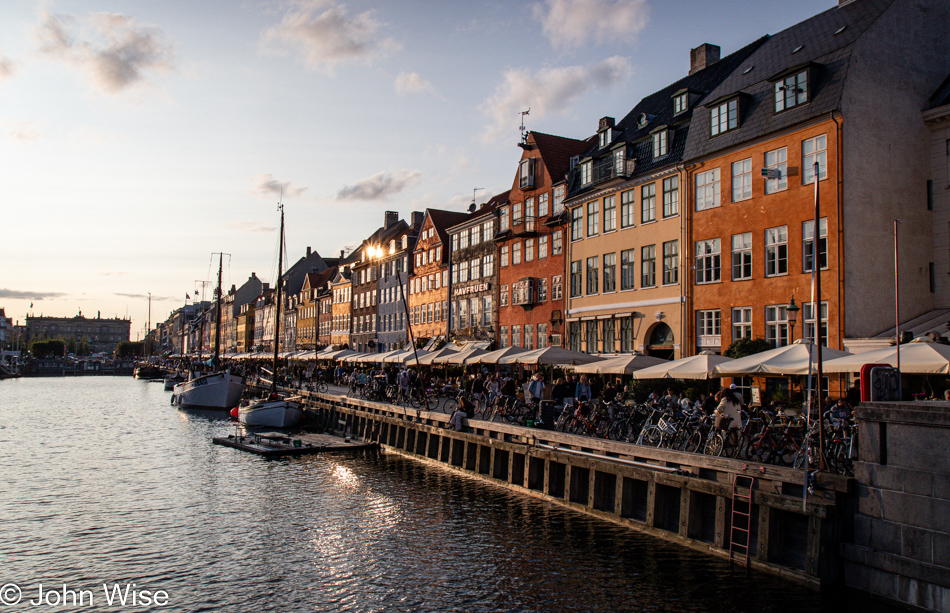
Possibly the most photographed spot in all of Denmark aside from the Little Mermaid: this is Nyhavn.
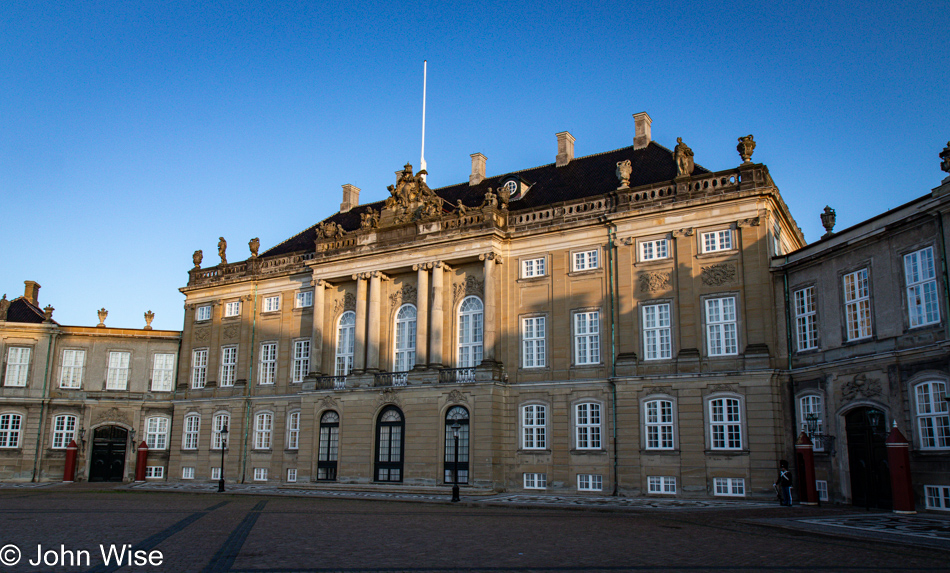
Amalienborg Palace is a massive complex that will remain unvisited by us aside from this walk through the courtyard because time will not allow a proper tour of the interior. This might also be due to some small amount of cynicism that we’ve seen plenty of ornate rooms where royalty has lavished opulence upon themselves in much the same way as other rulers have over the centuries. Intimate spaces lived in by artists and creators where we can gain a glimpse into their creative environments are far more interesting.
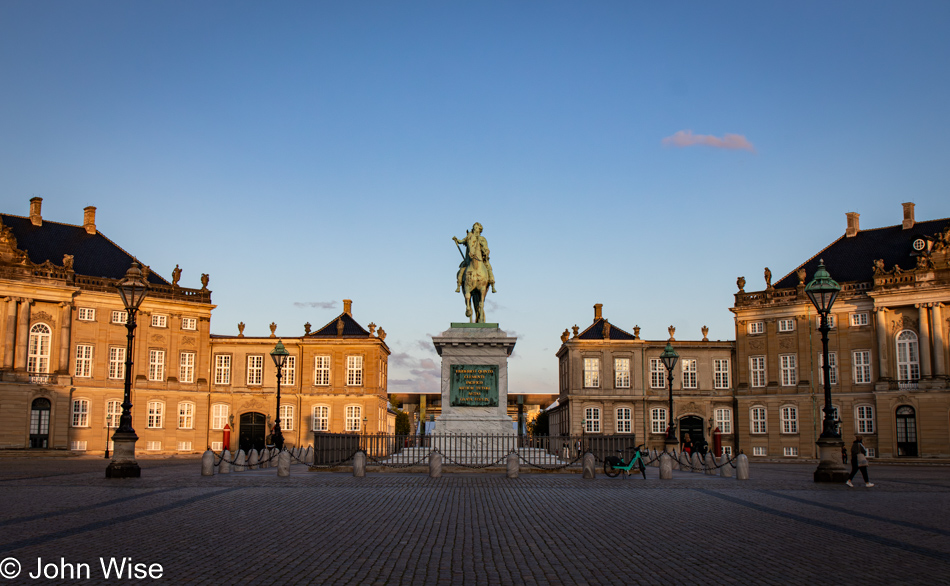
That’s King Christian V (1646 – 1699) mounted on his horse on the pedestal at center court.
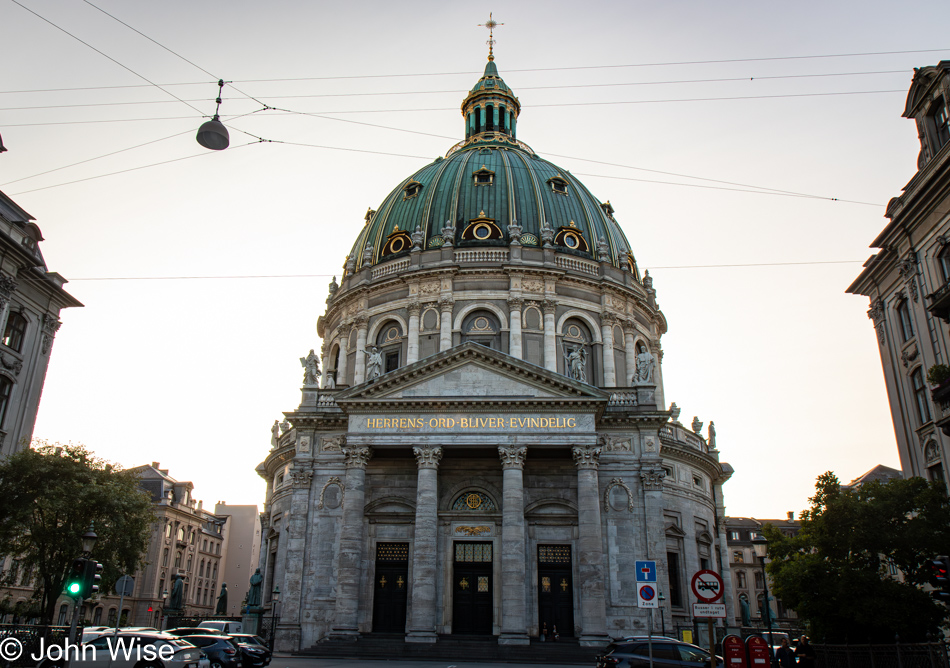
Back in 1749, King Frederick V (1723 – 1766) laid the foundation stone of Frederik’s Church, but after the death of the original architect six years later, the project fell into disrepair, and for over 100 years the building, what there was of it, lay in ruin. Construction commenced in the 1870s, and by 1894, the church was finally opened to the public for the first time. We were minutes too late to gain access to its interior, but will make an early morning attempt to visit the largest church dome in Scandinavia.
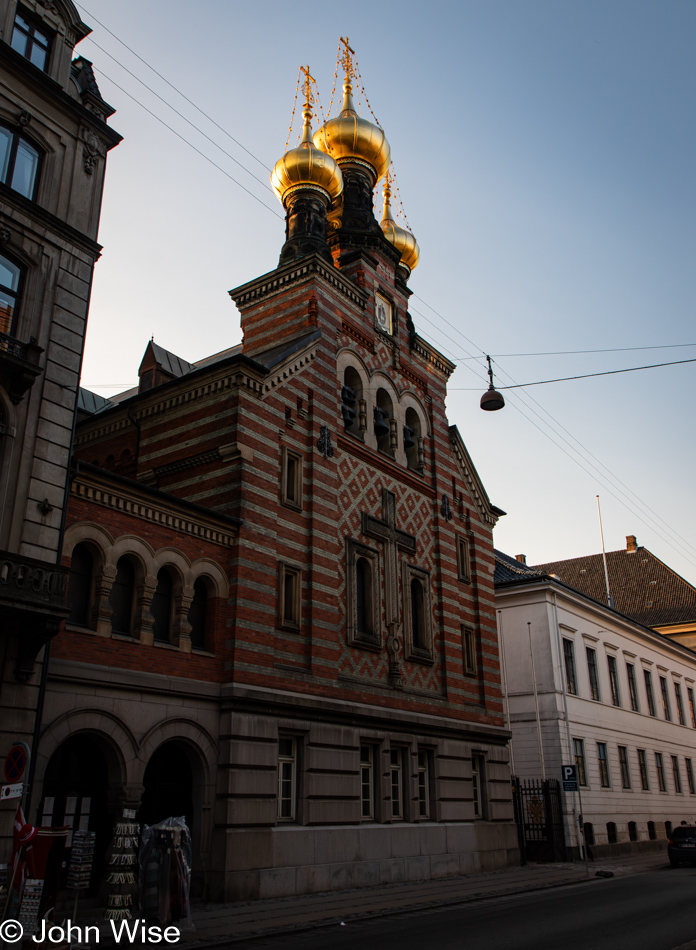
Had we been able to visit the Alexander Nevsky Church, it would likely have been the first Russian Orthodox church I’d ever stepped into. In keeping with our adage of leaving something undone that will bring us back, we added this to the list for Copenhagen, too.
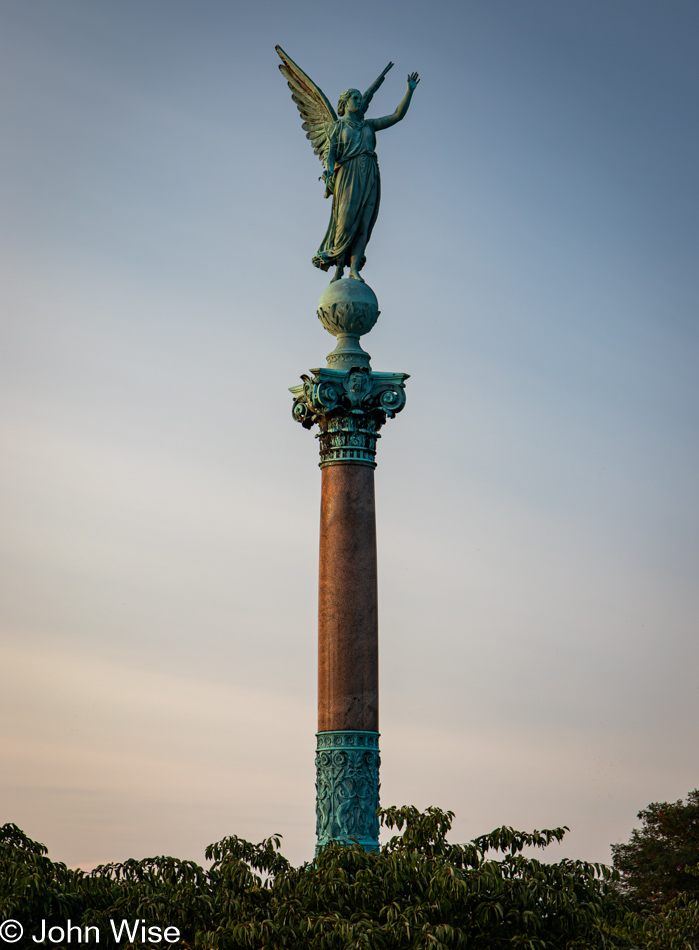
I’m beginning to think that most of the history worth remembering for Danes surrounds Christian V somehow. Here’s a statue in honor of Ivar Huitfeldt, a naval officer who was killed in action in 1710. His connection to King Christian V is that Ivar sent an application to the king when he was 16 years old, asking permission to join the Navy.
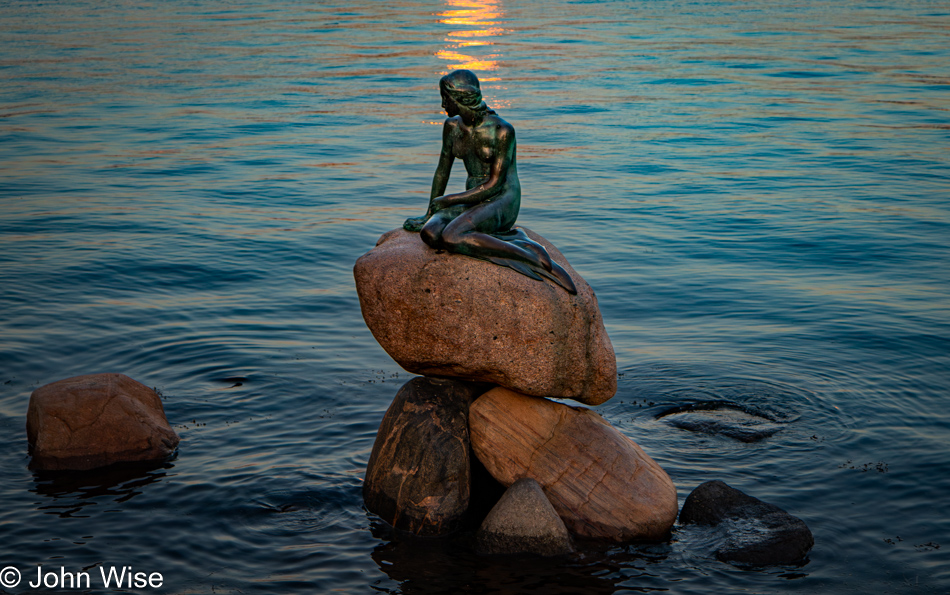
Yes, I know, it feels like a visit to the Little Mermaid is obligatory and gratuitous, but it’s on the way to something else.

That something else is the Genetically Modified Little Mermaid farther up the harbor.
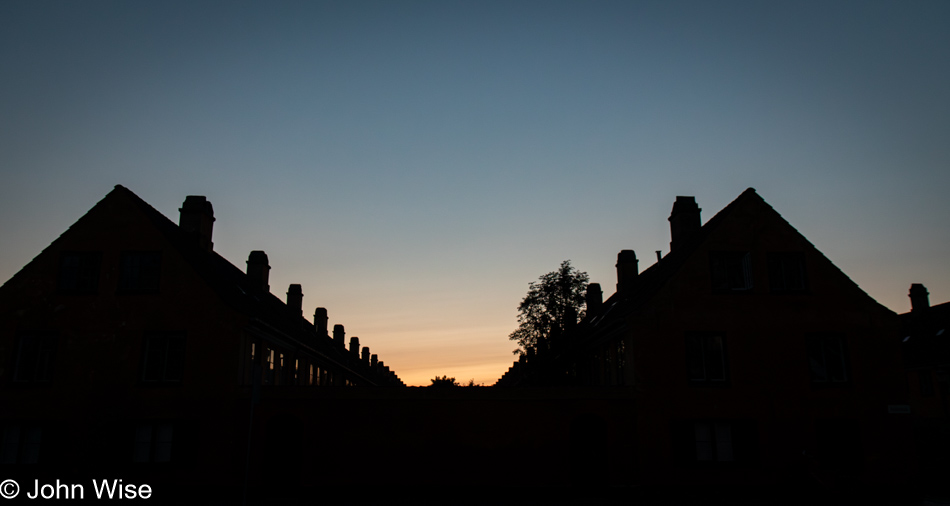
It was after 9:00 p.m. when we started considering our dinner choices, and while anything would have done at this point, kitchens around us were already closed. A pizza shop was packed with a long wait, but as we strolled along Store Kongensgade, we saw that Restaurant Vita was still serving. With beggars not able to be choosers, we took it. And anyway, taking the walk in Nyboder’s historic row house district at dusk had been more important. Begun in 1631 as Navy barracks, they are still standing and are now inhabited by civilians. It was almost 11:00 p.m. when we finally checked into our hotel and collected the bags they’d been holding for us.
[As it turned out, Restaurant Vita was a good choice. Unlike the table of loud and obnoxious Brits nearby, we enjoyed our food very much. After a starter of tartare, we tried the “other” national dish of Denmark: fried pork. I ordered stegt flæsk (slices of crispy fried pork belly), while John opted for flæskesteg (pork roast with a crispy fried crust). Both dishes were generous portions of delicious comfort food. Our server thought that stegt flæsk might be a bit too salty for novices, but we didn’t mind at all. It was reminiscent of chicharron, except it was served with boiled potatoes and parsley sauce. Since stegt flæsk comes in slices, it is often served “ad libitum,” which translates to “all you can eat.” We really lucked out stumbling over this restaurant serving very traditional Danish food. – Caroline]
As the title of this post suggests, there is a kind of culture shock that we are experiencing here in Copenhagen due to the politeness factor. From the front desk attendant at our hotel who earlier in the day was explaining the necessity for trust in Danish culture to someone else along the way who told us that if something weren’t safe, it would imply a greater societal problem, so obviously trust, a sense of decorum, and the sharing of those expectations with each other is part of the common dialogue here in Denmark. Compare this to where I was a week before in Arizona, where a gun on the hip tells others exactly how much trust is had for their fellow citizens.